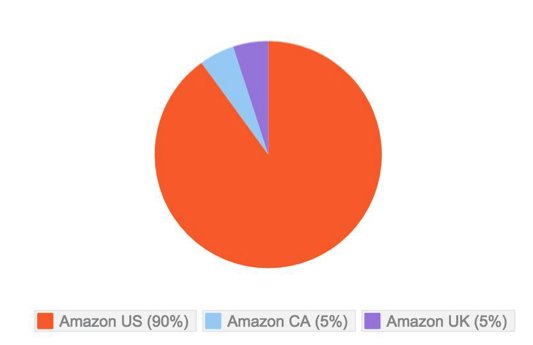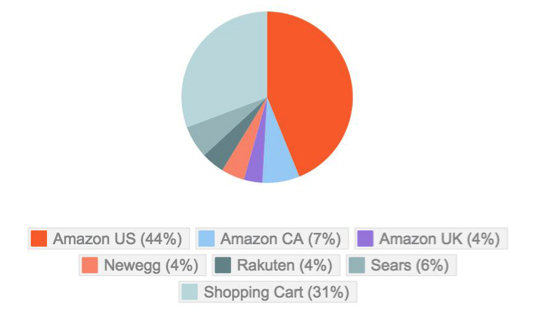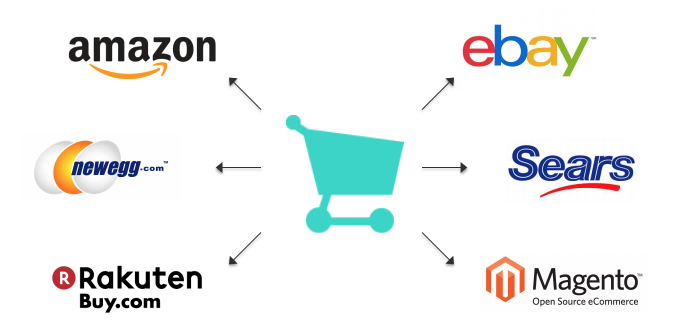Over the years, online sellers have focused all their attention selling on Amazon. Why? Because it is easy, Fulfillment by Amazon (FBA) makes it even easier and Amazon is simply killing it - 40% of all product searches are happening on Amazon!
Although Amazon should be a large percentage of your revenue, the big misconception in the e-commerce world is that the majority of your time and effort should be placed on selling on Amazon.
Here’s what a typical sellers revenue profile looks like that we speak to:
So, if purely focusing on your Amazon business is not what you should be spending your time on, what is?
Its selling on other marketplaces and building your own shopping cart — allowing you to capture the rest of the 60% of product searches that are happening everywhere. Ecommerce businesses who utilize multiple-marketplaces have a revenue profile that looks more like this:
The Importance of Selling on Multiple Marketplaces
Selling on multiple marketplaces offers several advantages for businesses and sellers, making it an important strategy for successful e-commerce operations. Here are 4 reasons why selling on multiple-marketplaces, including your own shopping cart is absolutely crucial to your success:
1. Be Everywhere
Selling online can be compared to a game of Monopoly. To succeed, you need to be everywhere on the board. Decrease your dependence on 1 marketplace. Think to yourself, would I ever invest in a stock with 1 customer?
2. People Vote With Their Mouse and Their Wallet
Getting visibility through ecommerce marketplaces exposes your product to the full amount of potential customers.
3. Own the Customer, With Your Own Shopping Cart
When customers purchase through your shopping cart you obtain the data to make smarter decisions and increase your targeted marketing efforts. You can also set up unique shopping cart features to create a smooth experience unique to your product.
4. More Profits
Top-line revenue will flow down to your bottom-line. The main purpose of incorporating multiple sales-channels for your business is to increase profits by increasing sales.
How to Start Selling on Multiple Platforms
Selling on multiple marketplaces requires careful planning, organization, and management, but it can be a lucrative strategy to expand your online sales and reach a wider customer base. If you're considering selling on multiple marketplaces, here are the general steps to get started:
1. Research and choose the right marketplaces
Conduct market research to identify which marketplaces align with your business goals, target audience, and product niche. Consider factors such as fees, audience size, competition, and seller requirements.
2. Set up seller accounts
Once you've identified the marketplaces you want to sell on, create seller accounts on each platform.
3. Optimize your listings
Each marketplace may have different listing requirements, so optimize your product listings accordingly. This may include creating compelling product titles, descriptions, and images that comply with each platform's guidelines and best practices. You could also consider using multi-channel listing software solutions and listing tools.
4. Manage inventory and orders
Establish an inventory and order management system to streamline operations across multiple marketplaces. This may involve using multichannel e-commerce tools or third-party integrations that centralize real-time inventory and order management.
5. Handle shipping and order fulfillment
Shipping and fulfillment can be complex when selling on multiple online store platforms. You can choose to fulfill orders in-house, work with pre-vetted third-party fulfillment providers, or use fulfillment programs offered by some marketplaces. It's important to have a clear plan for handling shipping and fulfillment logistics across different platforms to ensure smooth operations and customer satisfaction.
6. Manage pricing and promotions
Develop pricing and promotions strategies for each marketplace. Consider factors such as competition, customer behavior, and marketplace dynamics. You may need to adjust pricing and promotions based on each platform's performance to stay competitive and maximize sales.
7. Provide excellent customer service
Offer top-notch customer service to maintain a positive reputation on each marketplace. Establish clear customer service processes, promptly respond to customer inquiries and feedback, and handle returns and issues professionally and promptly.
Conclusion
We encourage you to start thinking of selling everywhere not just as space fillers, but also as real assets that make your business more visible and enhance profitability.
If you do, and you follow the concepts we went over in this article, you should see a real increase in your revenue, brand exposure, and overall profit.
Don’t worry if you can’t get on every marketplace right away. Start with one marketplace and expand from there. Start with building a storefront too!
Over time, as you expand more and more and work on optimization, you’ll see better results that will make a huge difference in your bottom line.
It’s a win-win: your e-commerce will gain more exposure, and your customers will gain access to the services you provide.
Work Smart. Sell More.
P.S. If you are struggling with managing your multi-marketplace e-commerce presence, here’s help.
Selling on Multiple Marketplaces FAQs
Which Marketplaces Should I Sell on?
The choice of multichannel selling options you should use depends on your business model, target audience, and product niche. Popular marketplaces that many retailers choose for selling items include Amazon, eBay, Etsy, Walmart, Shopify, and many others. It's essential to research and choose the platforms that align with your business goals and target customer base.
How do I manage inventory and orders across multiple marketplaces?
Inventory management across multiple online marketplaces can be challenging. You can use multichannel e-commerce tools or third-party integrations that centralize and automate inventory and order management. These tools can help you sync inventory, update product information, and streamline order processing across different marketplaces.
How do I measure the performance of my sales on multiple marketplaces?
Each marketplace provides online businesses with its own set of analytics and performance metrics to track sales, traffic, and other key performance indicators (KPIs). You can use these insights to evaluate the performance of your online sales on each platform and make data-driven decisions to optimize your sales strategies. Additionally, you can use third-party analytics tools to centralize data and gain a holistic view of your performance across multiple ecommerce platforms.










